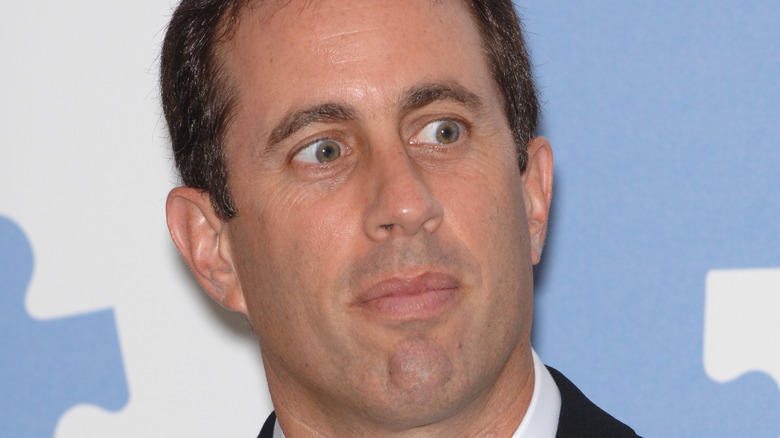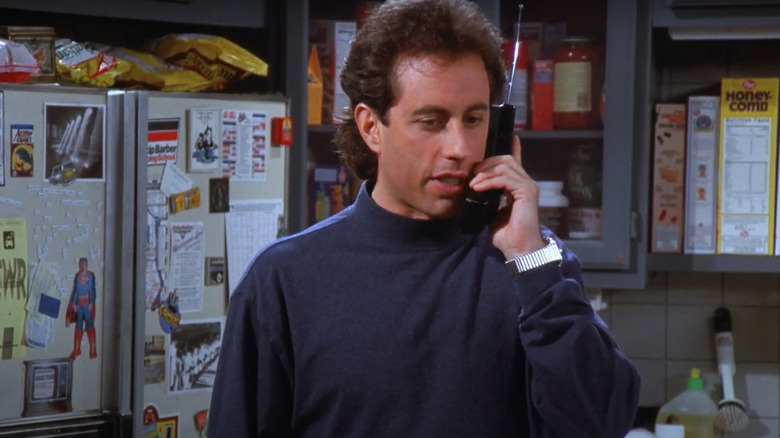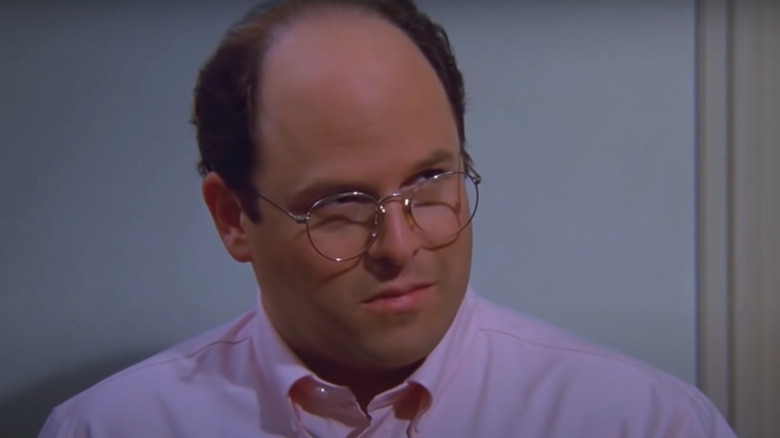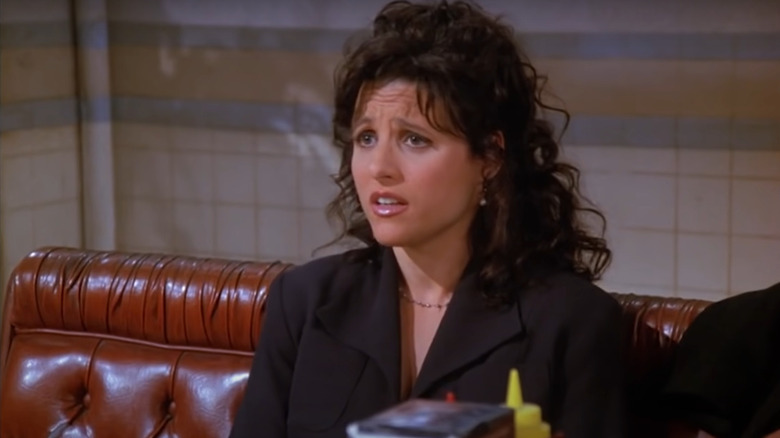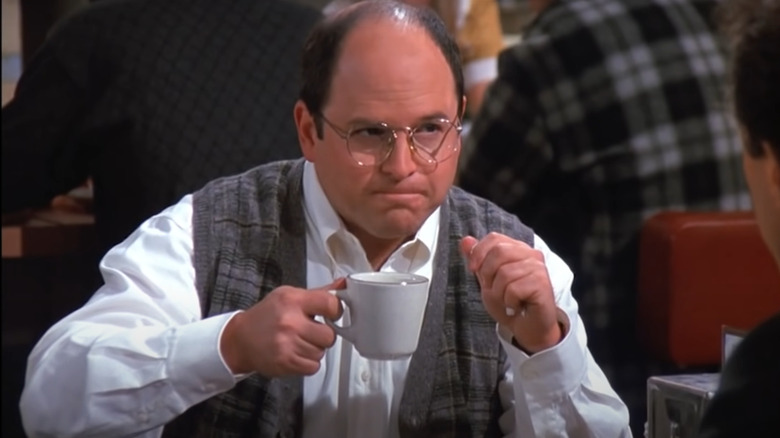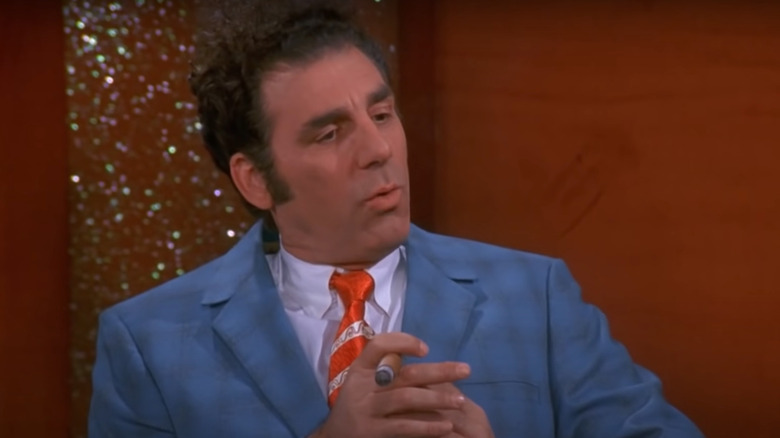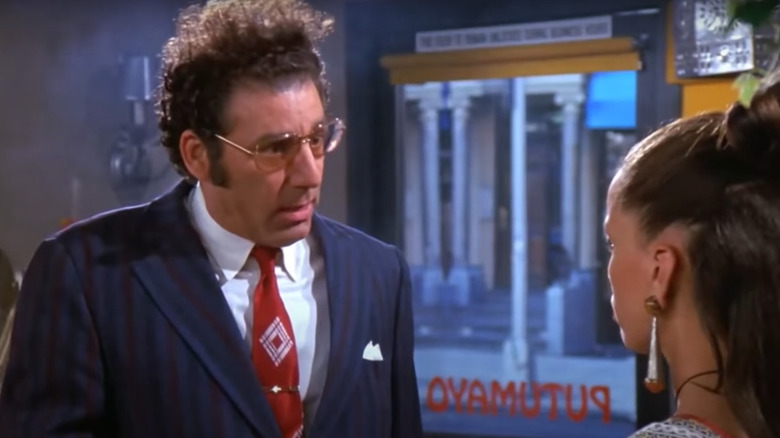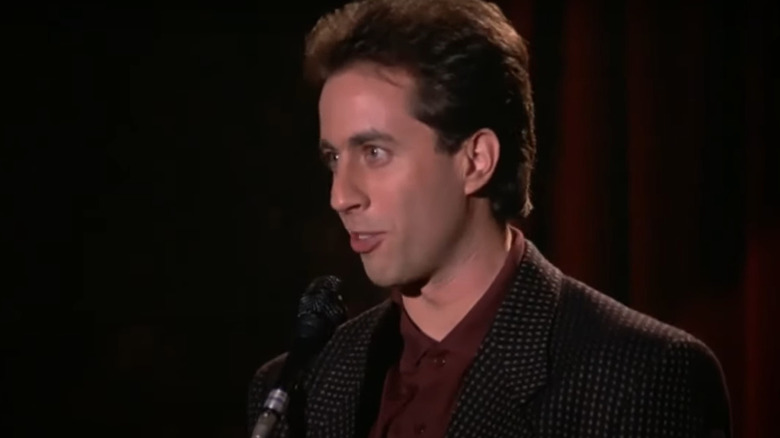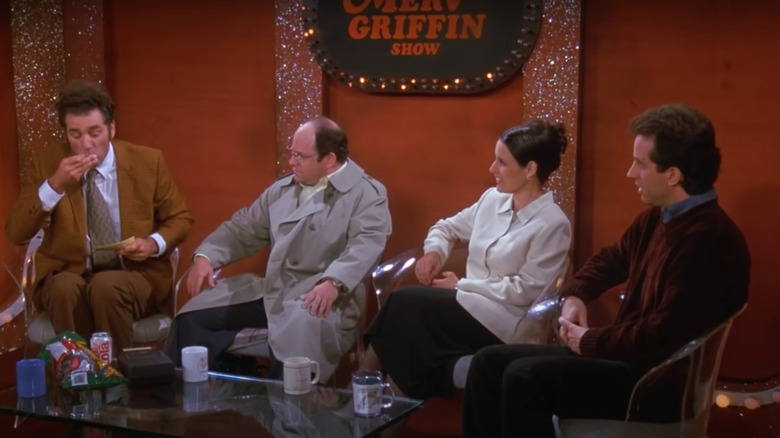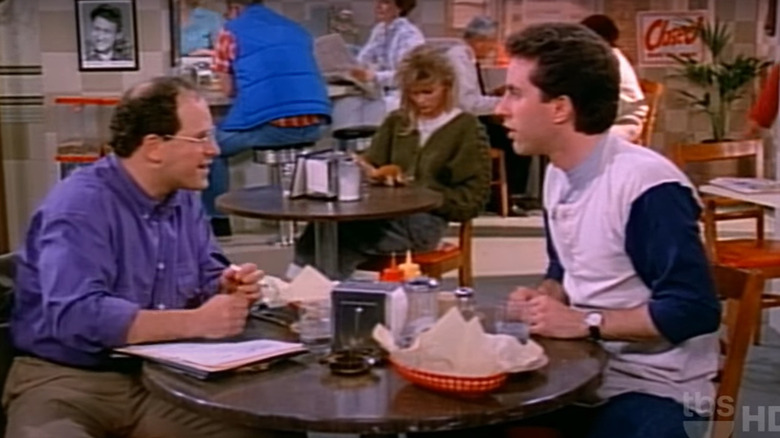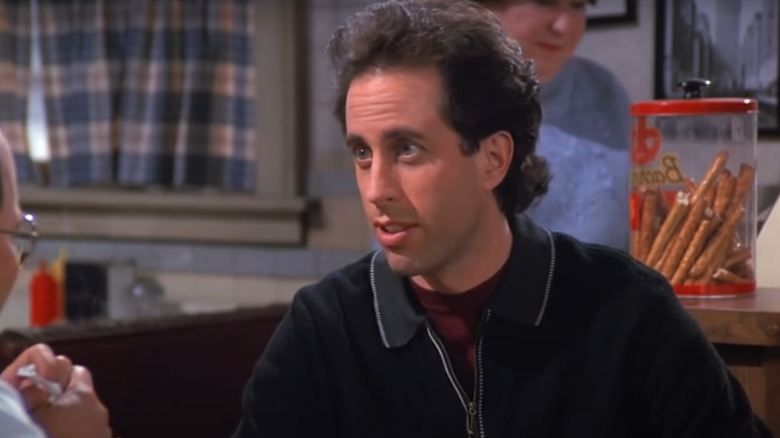The Untold Truth Of Seinfeld
NBC's "Seinfeld" was and continues to be a pop cultural empire, complete with a loyal following, immense staying power, and sizable spoils that have only ballooned with each passing year. Even 20 years after its record-shattering finale attracted a staggering 76 million viewers, the show's ripple effects can be felt everywhere. It has its very own lexicon which has snuck its way into everyday conversation almost undetected. It helped inspire countless situational comedies, including "It's Always Sunny in Philadelphia," and "Atlanta" (via The Guardian). It also changed the nature of sitcoms forever.
Perhaps most importantly, "Seinfeld" helped sitcoms realize their full potential, which lay beyond mushy storylines and smiling, wholesome characters. The show's shallow and fickle protagonists — the titular Jerry Seinfeld (played by the man himself), George Costanza (Jason Alexander), Kramer (Michael Richards), and Elaine Benes (Julia Louis-Dreyfus) — are hardly lovable, but their endless gaffes still commanded the viewers' attention. Co-creators Larry David and Jerry Seinfeld succeeded in excavating the most thigh-slapping, rib-tickling gags from the minutiae of the characters' frustrating lives.
Believe it or not, as many of the series' most dramatic and humorous moments took place offscreen as they did onscreen. From real-life inspirations for fictional characters to simmering tension between stars and producers, let's dig into the untold stories that shaped "Seinfeld."
Seinfeld got off to a rocky start
Not all hit shows begin as hit shows. "Seinfeld," for instance, ran into roadblocks with its very first episode. An NBC research memo on the pilot almost passed the series' death sentence. The test audience that formed the basis of the memo all but trashed the show's meandering plot and anti-heroic characters. Finally, it was the steely will of "Seinfeld" cheerleaders at NBC, including former president of entertainment Warren Littlefield, who saved the pilot.
Still, for one of network television's biggest successes, "Seinfeld" had an embarrassingly small first season order — a measly four episodes. Money for the season was transplanted from a scrapped Bob Hope special. After a series of false starts, the rest of the season finally hit the airwaves in 1990, but the sitcom's future remained uncertain. Audiences and network executives weren't the only spokes in the show's wheel; Larry David himself very nearly zapped "Seinfeld" before it could find its footing, as Littlefield told Fox News. The comedian declared himself creatively bankrupt and wanted to end the show. Luckily, Seinfeld persuaded David to squeeze out 13 more episodes, and then some.
Jason Alexander nearly left the show midway
While it's hard to picture any of "Seinfeld" without George's boisterous presence, one episode of the show does just that. Season 3's "The Pen" whisks Jerry and Elaine away from the New York bustle and away from George, depositing them in sunny Florida. George's fate during the episode remains entirely unknown.
While the writers' decision to omit George from the trip and the episode might have been accidental, it incensed Jason Alexander. In a move that seems close to his character's hot-headed temperament, Alexander flat-out threatened to exit the show. He reasoned that if "Seinfeld" could do without him for a single episode, it could do without him for its entirety. Alexander had sacrificed an illustrious Broadway career to star in "Seinfeld," so it seemed only fair that he would be supplied with substantial parts throughout the show. Needless to say, George went on to appear in every single episode of the remainder of the show.
Elaine's character almost didn't exist
"The Seinfeld Chronicles" — the moniker temporarily given to the first season of the show — had a very different premise than what it came to be known for. In fact, it lacked 25% of the greatest sitcom quartet in history: Elaine. When you first hear that "Seinfeld" was conceived without Elaine, the only appropriate reaction is to shove the person next to you and exclaim "Get out!" Today, a "Seinfeld" without Elaine's flailing dance moves, valiant crusades against smoking, affinity for big salads, and dislike for the Soup Nazis of this world seems unimaginable.
But the truth remains that Louis-Dreyfus' Elaine wasn't the female lead in the pilot and was introduced only in the second episode. The only prominent female character in the first installment was a waitress, Claire (Lee Garlington), whom Elaine would replace. Accounts of what prompted this change vary. One version of the story told by Jason Alexander assigns all the blame to Garlington for committing the cardinal showbiz sin of rewriting her dialogue. Others, like Warren Littlefield in page 84 of his book "Top of the Rock," claim the producers demanded a female character with a meatier role, and so David and Seinfeld created Elaine.
Larry David modeled George after himself
Most of the lead characters in "Seinfeld" are dramatized versions of real-life individuals. The life of Seinfeld the character, for instance, is a fictional retelling of the life of Seinfeld the comedian. Similarly, Larry David created the neurotic and insecure George Costanza in his own image. Various incidents in George's onscreen life, even wildly improbable acts like brazenly quitting his job one day and quietly returning the next, are examples of art imitating David's life, as Vulture and other sources have reported. David attempted similar shenanigans when employed at Saturday Night Live, albeit with less disastrous consequences.
The similarities between the two are made manifest in the "Seinfeld" reunion episode of David's show "Curb Your Enthusiasm." In a scene that could be a study of meta storytelling, Jason Alexander passes the mantle of playing George Costanza on to none other than Larry David, who proves once and for all that Jason Alexander is better at playing Larry David than Larry David is.
Kramer was initially named Kessler ... for legal purposes
In yet another example of "Seinfeld" mining real life for fictional characters, Kramer was loosely based on Larry David's quirky neighbor Kenny Kramer. Just like his fictional counterpart, Kenny would barge uninvited into David's apartment and feast on his food. Initially, Kenny did not easily consent to his name and likeness being used on network television, as Jennifer Keishin Armstrong writes in her book "Seinfeldia: How a Show About Nothing Changed Everything."
In fact, Kenny Kramer attempted to negotiate with the producers. He'd let them use his last name in exchange for the role of Kramer and a sizable remuneration. In an attempt to circumvent these demands, Seinfeld and David briefly resorted to tweaking the character's name to "Kessler," a change which even found its way into the pilot but fizzled out soon after. Eventually, the two parties struck a bargain — royalties to Kenny Kramer in return for the soon-to-be-iconic name of Kramer. True to their reputation for turning anything and everything into a joke, David and Seinfeld built an entire plotline around this incident in Season 4.
Michael Richards picked out his own costumes
Michael Richards not only played Kramer to perfection, he also occasionally played his stylist. As the show's costume designer Charmaine Simmons relayed to The Baltimore Sun, Richards helped her meticulously put together his character's classic retro attire.
Kramer's look was less a fashion statement and more a costumed manifestation of his tendencies to hoard and thrift. His clothes have a '50s quality to them mainly because they are literally from that era. "These are the clothes [Kramer's] always just worn, and never bought any new clothes," explained Richards to P.O.V. Magazine.
Of course, Kramer's consistent fashion choices also meant that he would sport the same pair of shoes throughout the series' nine-year run. In a way, the actor's slapstick routine hinged on the kind of mobility his attire afforded him. His shoes in particular required a buoyancy that could enable him to waltz into Jerry's apartment at the speed of light, among other hijinks.
Jerry's stand-up routines concluded partly due to Larry David's exit
During most of the show's run, each "Seinfeld" episode is cleanly interspersed with segments from the comedian's stand-up routines. Over seven seasons, these segues serve as an important framing device, without which it would be hard to stitch Seinfeld's stand-up roots together with the show's various story arcs. Since "Seinfeld" was envisioned as an attempt to tell the story behind a comedian's routine, these segments proved central to the show.
When it came time for an eighth season, however, Seinfeld axed his own stand-up segments. When Larry David exited at the close of the seventh season, Seinfeld took over for David as the showrunner, even while continuing to star in the show himself. According to "Seinfeld FAQ" by Nicholas Nigro, the comedian's new and enhanced offscreen roles and responsibilities ate into his time, leaving him with only enough to play the lead character in the sitcom. Meanwhile, Seinfeld and his team of writers also decided that the stand-up segments ended up diluting crucial jokes and plotlines, and the show was better off scrapping them.
Newman doesn't have a full name
We're so accustomed to Jerry accusingly exclaiming "Newman!" that the need to ascribe a second name to the character never quite arises. "Newman!" practically became a catchphrase, so why would any reasonable person want to ruin a perfectly good moniker?
Newman is referred to by a different name — "Norman" — only once in the show. In the episode "The Bottle Deposit, Part 2," Newman's love interest calls him Norman. While this was a flub on part of the actor, the humor in mispronouncing one of the show's most popular catchphrases wasn't lost on the producers. The scene thus didn't wind up on the cutting room floor. Even in scenes requiring his full name, Newman is given none. The name on the postman's business card reads only "NEWMAN." When a traffic misdemeanor lands him in court, Seinfeld's neighbor is addressed by the only name we've known — Newman.
Seinfeld was never a show about nothing
In its fourth season, "Seinfeld" weaved in a meta-storyline about the fictional Jerry Seinfeld creating a "show about nothing" for NBC. While "Seinfeld" was smartly parodying life behind the sitcom screens, audiences and critics alike assumed the show was being cheeky and self-referential. Of course, a meta-plotline that revolves around a "show about nothing" further works to reinforce that narrative. A show that has nothing to say about the world may as well talk about itself.
But Jerry Seinfeld himself rubbished that claim in an interview with The Hollywood Reporter, blaming the press for drawing parallels between the show and the show-within-the-show. The comedian declared that "Seinfeld" has always delivered commentary on the comedy scene in New York City. Indeed, if the "show about nothing" slogan was true, it may be because nothing like "Seinfeld" had ever aired on network television before.
Seinfeld's last conversation with George mirrors their first interaction
In "The Finale," after being jailed for committing the offense of "criminal indifference," the "Seinfeld" foursome don't pause to reflect on their actions. Instead, they slip right back into their old routine of snarky conversations about — you guessed it — nothing in particular. Jerry attempts to criticize George's shirt and its oddly placed buttons only to realize, at his friend's prompting, that the conversation almost exactly resembles one they've had before. In fact, the pilot begins with Jerry uttering those very words.
The scene is a microcosm of the entire show and its mantra of "no hugging, no learning." Larry David famously mandated said writing principles to avoid the didactic, motivational storytelling that most sitcoms were known for at the time. In keeping with these cardinal rules, Jerry and George are shown to have learned so little over nine seasons that they wind up right back where they began — in a prison of their own making, only this time, literally.
Jerry turned down an astronomical amount of money for one more season
"Seinfeld" seems to have borrowed from George's sound philosophy of "going out on a high note," for the series wrapped up even as it peaked. But NBC wasn't about to let its gravy train leave the station that easily. Head honcho Warren Littlefield made Seinfeld an offer he almost couldn't refuse, as the former executive told Fox News. His team put forth an unprecedented amount of money for a Season 10: $100 million.
Unfortunately for NBC, Seinfeld's point of contention wasn't insufficient compensation or even a lack of creative inspiration, as David claimed at the beginning of the show. As it turns out, it was the comedian's personal life that was wanting, not his professional aspirations. "I don't have a life, I'm not married, I don't have kids," Seinfeld was quoted as saying. Littlefield and NBC freed the comedian of his many professional obligations and concluded the series.
